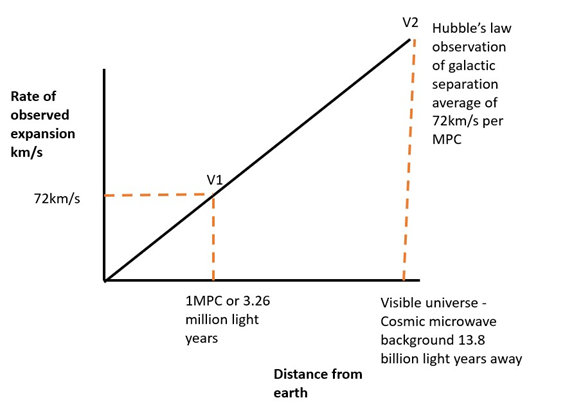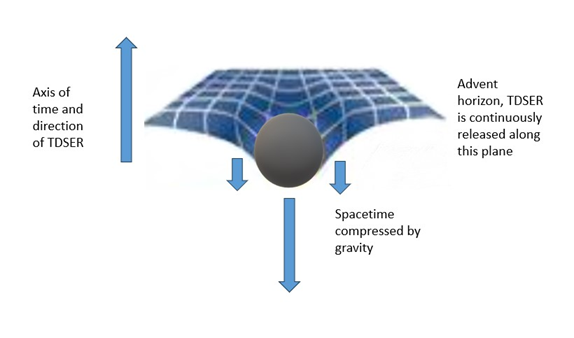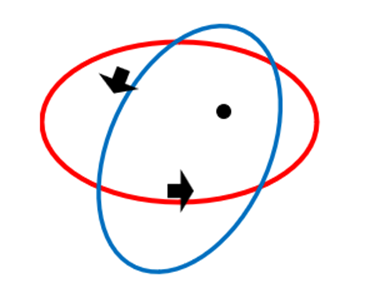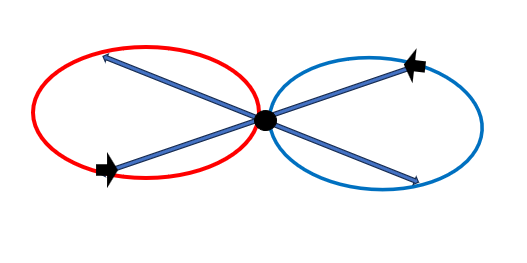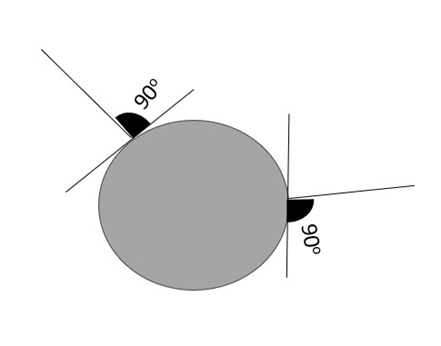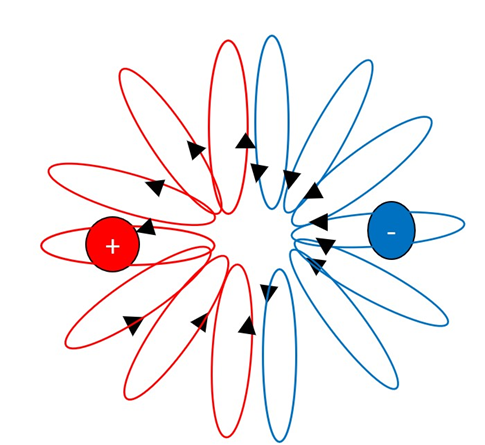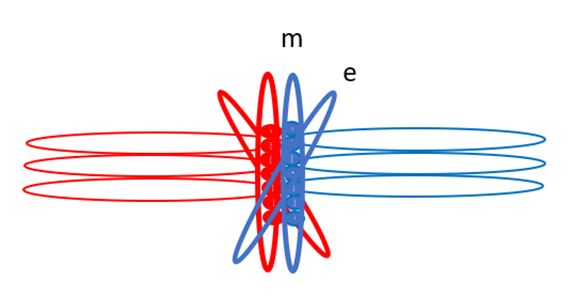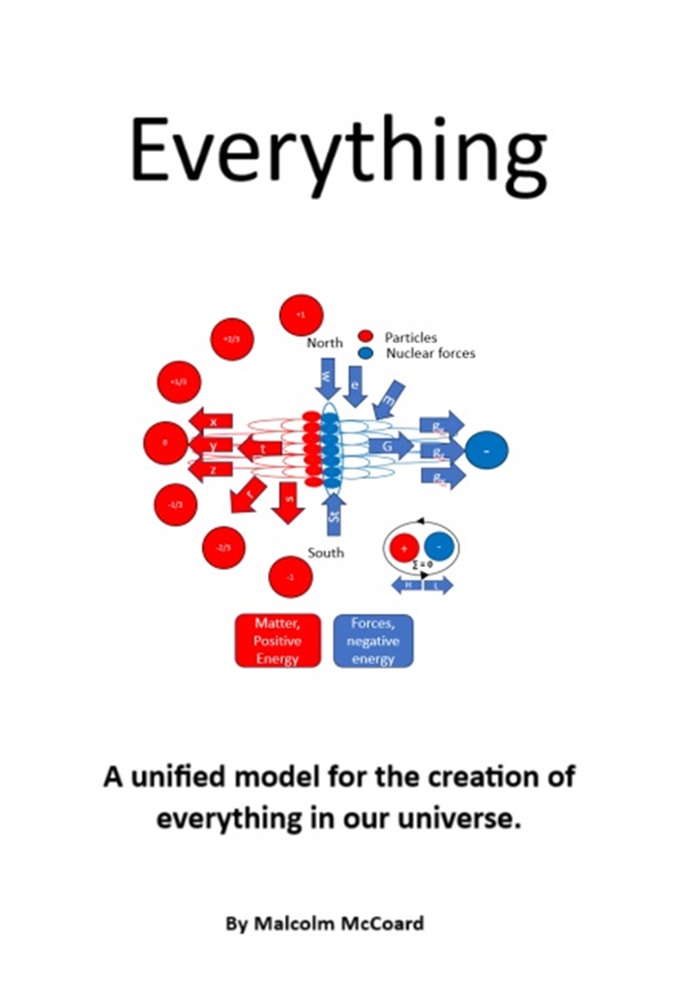
Everything
This article is based on the authors book "Everything" published February 2024 as an e book or paperback on amazon. Follow the links below:
Time Dilated Spacetime Energy Release or TDSER
TDSER is a radical new theory of space and time, which answers this question. It uses simple established physics to explain what causes the passage of time, how the same effect predicts a universal force of gravity and explains dark energy and dark matter. No complex maths, just simple logic explained for the layperson.
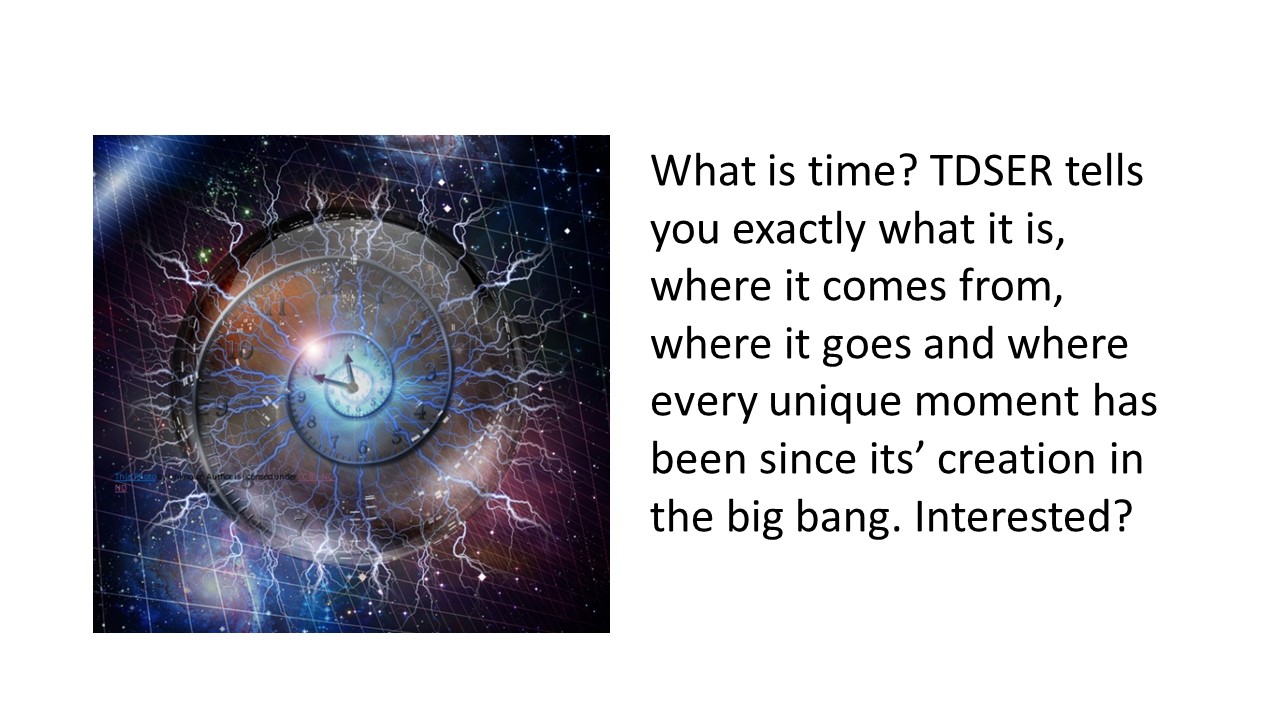
What is time? It's such a fundamental part of our reality, yet we don't actually have an accepted answer. Common explanations include: that time is a dimension, a vector, a property of spacetime or that the universe is pre-programmed to move towards a state of increasing disorder called entropy. Einstein modelled gravity, using time as a 4th dimension of the fabric of space, commonly referred to as spacetime, but time doesn’t behave like the other spatial dimensions. Time is irreversible and dynamic, allowing cause in one moment, to move to effect in the next, everywhere. It is fleeting, arriving in an instant, then after that moment we call ‘now,’ mysteriously disappears. Einstein showed that time can be warped by extreme speed (special relativity) and gravity (general relativity). Yet away from these extreme conditions, it has a constant predictable beat you could set your watch by!
Consider the moment you started reading this article. Whatever it was, it happened. It was real; it gave rise to cause-and-effect, evidenced by the memories now stored in the neurons of your brain. It wasn’t just a vector or a coordinate along a temporal dimension nor simply a universal property of spacetime. These are mathematical concepts, they do not result in cause-and-effect. Universal properties apply everywhere and are repeatable. That moment was something real and unique, it had specific consequences that will never be repeated. But everything real, whether transient like energy or solid like matter, originated in the big bang. So if it's real, then where has that moment been for the last 13.8 billion years? If the big bang happened everywhere, it didn’t have ‘far’ to travel either. It's an uncomfortable question!
A new theory, Time Dilated Spacetime Energy Release or TSDER proposes an essentially simple answer, starting with a paradigm shift on the big bang. One that offers a perfect cause-and-effect fit with how we experience time and gravity and is consistent with both special and general relativity (which I will explain shortly, in simple terms). TDSER provides a cause and effect theory of time, gravity, dark matter and dark energy and the creation of our universe, where conventional theories describe these only as effects.
Let’s start with the first moments of time. In the conventional big bang theory, a tiny infinitely dense point of spacetime spontaneously comes into existence (an unexplained effect). The spatial dimensions are already created (again unexplained) and are then ‘inflated’ to infinity in a fraction of a second, to create our universe, everywhere. Expansion occurs at infinite speed, then suddenly slows rapidly (again neither is explained). The energy released, in what is known as the ‘hot big bang,’ coalesces to form all the matter and radiation in our universe. A universe that goes on expanding, now doing so at an accelerating rate, driven by completely unexplained dark energy. Matter coalesces into stars and galaxies, under the influence of gravity, but there’s not nearly enough. Unobserved dark matter is required. Together unexplained dark matter and unobserved dark energy account for 95% of everything in our universe. Unsurprisingly many scientists are starting to question if we might have got something fundamentally wrong.
Whatever time is, it enables cause in one moment to result in an effect in the next. If we understood time, might we also glimpse the true nature of our universe in terms of cause-and-effect?
Einstein visualised spacetime as a 4-dimensional ‘fabric’, compressed and distorted by the presence of matter; itself a highly concentrated form of energy. The greater the energy density or mass, the greater the distortion of spacetime. With gravitational compression of spacetime, comes a slowing of time, from an observer’s perspective, outside that compression. Within a black hole, the effect is so severe, that time approaches zero. This is time dilation, predicted by general relativity (Einstein. A, 1916). Matter which fell into a black hole billions of years ago, to us as remote observers, still travels to its core today. Its gravity still affecting the stars around it.
General relativity suggests time might be a function of the compression of spatial dimensions. If we could apply severe time dilation to the extreme energy conditions of the big bang, this could certainly account for where our moment has been since the big bang. In fact, I see no alternative!
However, there are two problems with this proposition. Firstly, the early universe did not collapse into a black hole, creating time dilation, although the energy density exceeded that required. Gravitational collapse of matter and spacetime into a black hole, is predicted for stars and objects of fixed dimensions under extreme gravity, but the early universe had no fixed dimensions and these equations don’t apply to expanding space. However, what if there was compression prior to expansion? Might compressive forces have ended inflation? Secondly, this proposition requires an ongoing ‘cold’ big bang, or we’d all simply be vapourised. Both are in fact logical outcome of the hypothesis, I will present.
Time is dynamic, for cause in one moment, to result in effect in the next, there must be movement everywhere. Einstein’s theory of special relativity (Einstein A, 1911), demonstrated that time is distorted by motion. Our universe also expands everywhere and has always done so.
These highlighted observations are the basis for a new hypothesis; Time Dilated Spacetime Energy Release or TSDER (McCoard M, 2023).
In essence, TDSER proposes a modified big bang, where the infinite inflation of the big bang ends because of the exponential growth of reciprocal dimensional forces (gravity) created by this expansion. I will justify this shortly. Inflation therefore ends in a state of massive compression everywhere, compressing spatial dimensions along a 4th temporal axis resulting in extreme time dilation. This violent deceleration ends inflation and initiates the hot big bang. Violent expansion, due to an effect called radiation pressure, 'pops - the cork' on the early universe, delivering a synchronised and uniform expansion over the 'advent horizon' created. An open end on compressed time dilated spacetime, from which 'cold' time dilated spacetime moments still pour, at a constant rate moderated by a universal force which is the basis of what we call gravity.
There's a lot in there, much of which I have yet to justify. I will do so, but it helps to have an overview. You will only fully appreciate TDSER, when you start to see the whole picture. I'll start by showing you the fit with how we experience time, then maybe you'll allow me 'a moment' to explain (cause-and-effect) where this force of gravity has come from.
TDSER says that what we perceive as the passage of time, is actually the continuous dynamic time-dilated release and decompression of highly compressed spatial dimensions along a temporal axis. The net effect of this release and dynamic decompression is what we perceive as the vector of time. We exist in the continuous transient moment of expansion, which we call 'now.' Once released and decompressed, that moment has passed and the universe has expanded. So each moment was something real, it has passed, but it has not just disappeared. Whatever comprises compressed spacetime (and we're coming to that shortly) has been conserved. Cause in one moment can therefore give rise to effect, in any spatial dimension in the next. Time flows from one moment of spacetime release to the next, everywhere in our spacetime universe. The arrow of time points in the direction of spacetime release, the temporal dimension, cutting our reality everywhere.
In the conventional big bang, the 3 spatial dimensions are inflated to infinity in a fraction of a second, to create a universe everywhere, but the effect on the temporal dimension is ignored. Why? TDSER says spacetime as a whole was inflated along the 4th temporal dimension, creating infinite layers of spacetime ‘moments.’ Each layer, compressed by the extreme gravity of the early universe, is then released continuously, in a time dilated manner (over billions of years to us, as observers in previously released spacetime) along the axis of time.
This rapid and continuous release and decompression of spacetime is why each moment is so fleeting. A cosmic clock, set by the uniform conditions of the big bang. Evidenced in the uniform (or isothermal) and invariant signature of the cosmic microwave background; the first visible light in our universe.
Moments of spacetime decompress in proportion to the energy density of the local universe. Thus matching the compression due to the local mass (or energy density of the universe) Einstein proposed in his theory of general relativity. TDSER therefore does not change the properties of spacetime and all Einstein's equations apply.
There is limited potential to test TDSER mathematically. TDSER does not change the behaviour of spacetime. Rather, it explains why our universe behaves as it does. However, we can compare it against current theories and test both against verifiable observations. TDSER challenges many established paradigms. So, I have set a high bar; to demonstrate TDSER is consistent with and can explain, in terms of cause-and-effect, our universe at all scales. I have set 5 tests, in each case conventional theory describes only the effect:
1 How we experience time, including special and general relativity,
2 Dark energy and dark matter,
3 The quantum world, specifically force carrying messenger particles,
4 Gravity and inertia,
5 A credible TDSER big bang; delivering a one-off hot big bang, time dilation, matter and radiation.
With TDSER, the universe expands in all spatial dimensions, at the moment we call ‘now,’ as a continuous stream of spacetime moments decompresses everywhere. Cause in one moment of release, can therefore move to effect in the next. Time is dynamic and once expanded, that moment has passed and spacetime has expanded everywhere. The arrow of time is set by the irreversible release and expansion of spacetime from subspace. The vector of time points along the temporal axis at the moment of release.
TDSER asserts that spacetime is fundamentally composed of energy. At the moment of creation, the big bang, there was literally nothing else. It behaves as energy does; interacting with other forms of energy, being compressed by matter and carrying waves. Compressed spacetime stores gravitational potential energy in Newton’s apple above the earth, before being converted to equal quantities of other forms; kinetic energy and heat through friction, as the apple falls.
However, if spacetime is fundamentally composed of energy. How can energy alone create our dimensions? What holds this energy together? In the conventional big bang dimensions just exist, there is no attempt to justify their creation.
Einstein showed that all matter was energy. Something binds this energy, holding it together, as particles within an atom or the energy in a fundamental particle. A matching force is required.
TDSER uses 2 equations to create our reality. Einstein demonstrated that matter is another form of energy, through his most famous equation; energy (e) equals mass (m) times the speed of light (c) squared:
e = mc2 Eq. 1
Newton’s second law (Newton I, 1687) states that the force (F), required to accelerate an object, is the product of its mass (m) and the rate of acceleration (a). Normally denoted:
F = ma Eq.2
If mass and energy are interchangeable, then as energy is released and decompressed over the advent horizon, it is accelerated and a force must be created. A force is often defined, as that which changes the momentum of an object; a change in the momentum of energy. A photon has no mass, yet it is a form of energy and possesses momentum. Solar sails may one day carry probes through outer space, using the momentum of photons.
Note, it is not normal to apply Newton’s law this way. Traditionally, gravity can exist without energy movement. However, Eq. 2 is a mathematical equivalence. Force is a product of mass (a form of energy) and acceleration. We have no such problems with Einstein’s equation. Newton’s equation demonstrates that force and energy are also two sides of the same coin. As Einstein’s demonstrates energy and mass are. So, TDSER asserts that:
Wherever there is a change in the momentum of energy, we always create a force.
Follow the maths and our reality starts to make sense.
Current theories of gravity, including Einstein’s bending of spacetime, cannot explain why all matter, however small or distant, is drawn together. This is essential for structure to develop in the early universe. Theoretical particles, gravitons have been proposed, but need to be exchanged by every particle in the universe simultaneously and cause instantaneous attraction, no matter how distant! With TDSER, the constant release of spacetime energy, the change in the momentum of energy everywhere, creates a corresponding force. We have cause-and-effect, a reciprocal or ‘gravitational’ force, acting in the opposite direction to TDSER everywhere.
A force, which acts on any concentrated form of energy with aligned spatial dimensions, i.e., matter, in proportion to its energy content in those dimensions or mass. Mass therefore increases gravitational forces. It does not yet explain the compression of spacetime.
If we apply an unbalanced force to this mass, a proportional reciprocal force must also act to resist its movement. This provides a cause-and-effect explanation for the force we call inertia. Stop the unbalanced force and the inertial force stops, but gravity still acts on the object. In conventional physics gravity and inertia just exist, they are effects described by Newton and Einstein in very different ways. TDSER provides us with cause and effect.
The big bang theory is based on Hubble’s observations of distant stars, receding away from us in every direction. A universe expanding in all directions, no matter where we look. If we roll back time, this expansion suggests a beginning to our universe. To explain this, we are told that an infinitesimally small region of spacetime with infinite energy appears from nowhere and expands exponentially.
Spatial dimensions are already inexplicably established and are ‘inflated’ to infinity in a fraction of a second, to create a universe everywhere. The driving force for beyond light speed inflation of spacetime is also unexplained. Inflation along the 4th temporal dimension is essentially ignored. Why do we choose to ignore time during inflation? After all, we have a seemingly infinite supply of almost infinitely tiny moments of time, spread across the last 13.8 billion years. Each second divisible into billionths by atomic clocks.
TDSER also proposes that the spatial dimensions are inflated to infinity instantaneously. It says that spacetime is energy, so propagation to create an energy universe, without any opposing force (at least initially), must be at infinite speed. The reciprocal forces of ‘gravity’ must therefore also undergo exponential growth. This halts inflation leaving a near infinite universe, massively compressed. Infinite spacetime moments are compressed along the temporal axis and massive time dilation must follow.
Massive deceleration and compression tears apart spacetime, releasing energy and radiation in the hot big bang. Massive 'radiation pressure' is created, time dilated spacetime, supersaturated with energy in all dimensions. Something has to give. Radiation pressure is an established effect, whereby the momentum of photons released from a star eventually overcomes the massive gravitational forces drawing matter (energy) towards it. Stars can grow no larger. This one-off hot big bang ‘pops the cork’ on our early universe; releasing massive energy and triggering expansion everywhere, at exactly the same energy density. An ‘advent horizon’ has been created across which TDSER can expand less violently to the current day.
Not all spacetime was destroyed. ‘Inflation’ (or rather as we will establish later, propagation of a basic energy structure), has not stopped. It has slowed to a pace now moderated by the reciprocal or gravitational dimensional forces created by the change in energy momentum of release across the advent horizon. Infinite layers of compressed spatial dimensions or moments are then released (over billions of years to us, as observers in previously released spacetime), along a temporal axis. This answers the question of where each moment has been since the big bang. Each spacetime moment is compressed in a time dilated ‘subspace layer’ and hidden from our spatial reality, being aligned along a temporal axis. The opposite effect to matter and spacetime, drawn into a black hole billions of years ago, yet from our perspective outside, still travels invisibly to its core.
Newton’s first law (Newton I, 1687), says an object (energy) travels at constant speed, unless acted on by an unbalanced force. Any spacetime dimensional energy without mass, would travel at infinite speed, were there not a balancing gravitational force, to match that exerted by its decompression from subspace. TDSER attains a constant velocity in all spatial dimensions as it is released across the advent horizon. A universal clock ticks at a constant speed everywhere, unless affected by the density of the local universe. A cosmic clock, synchronised by the uniform conditions of the hot big bang.
Essentially, TDSER says that the 4th temporal dimension, the vector of time, is only present at the moment we call now. We cannot therefore move into the past or future in the way we move through spatial dimensions.
The extent of decompression is set by the local energy density of the universe. This sets the rate of decompression and hence determines the passage of time; providing a cause-and-effect explanation for gravitational time dilation.
What evidence is there for subspace? Consider 2 black holes at the centre of distant galaxies, they have separate gravitational centres. Matter, radiation and spacetime are compressed and drawn towards their cores, but not towards a common centre of the universe. Black holes can form anywhere, suggesting that there is at least a 2-dimensional plane present. If black holes can form at any time, we have an infinite number of such layers, aligned on a temporal axis. Blackholes suggest the presence of a 3-dimensional subspace structure. Just not our familiar spatial dimensions.
Once fully decompressed, the fleeting moment we call ‘now’ has passed and space has expanded, without dilution of its properties (another clear flaw with the current expansion model) or unexplained dark energy. If you prefer, the potential energy released by decompressing TDSER, is dark energy.
Expansion of spacetime in proportion to its energy density, into an increasingly larger and therefore more dilute universe, explains the current acceleration of this expansion. A tipping point is a logical outcome with TDSER, where gravity can no longer slow the expansion of spacetime into an increasingly less energy dense universe. The energy for universal expansion and conditions for new spacetime creation are attributable to the conditions present in the big bang. The only conditions we know of, capable of creating spacetime. Where are the conditions necessary for spacetime creation in the fully cooled voids of space with the current model?
What is the speed of universal expansion? Observations show that the further a galaxy is away from us, the faster it moves. This is the Hubble constant, estimates vary, but I’ll take an average of 72 km/s/MPC. 1MPC being a megaparsec or 3.3 million light years.
With TDSER, dimensions are energy, released without mass, into an existing universe. Dimensional expansion should therefore be at the speed of light. Light’s speed is constant, so too the passage of time, unless affected locally by gravity or velocity. For time-based interactions and cause-and-effect between photons, it also has to be the speed of light. Here, there is mathematical proof, based on (Tommasi J. November 2022).
Hubble’s Law, is a straight-line relationship between the separation of galaxies and the speed they move away from us. A galaxy 1 MPC away from the earth, will be moving away at 72km/s. This is our first ‘fixed’ point. Light from this galaxy takes a year to arrive.
To estimate the rate of dimensional expansion, we can look out to the edge of the visible universe, the Cosmic Microwave Background or CMB. This radiation, unaffected by gravity, must match the rate of expansion of spacetime itself. The CMB is believed to have been emitted 13.8 billion years ago, so that gives us a second ‘fixed’ point. We can put another fictional galaxy at this point, and similarly calculate the speed the CMB is moving away from us.
Refer to figure 1 below
We can calculate V2, the rate of expansion at the CMB, by proportion.
V2/72,000m/s = 13.8x10 exp9 /3.26x10 exp 6
V2 = 3.0x10 exp8m/s. The speed of light.
So, the spatial dimensions of our universe are expanding at the speed of light and have always done so.
Light travels through spacetime, but any movement by definition requires time. Speed is distance travelled divided by time taken. Light or any other energy without mass, can only therefore move as fast as time is created. According to TDSER, this is the rate at which spacetime is released and decompressed. The rate we have just calculated. To move any faster, it would catch the previous moment, a moment which has not yet been released, effectively moving back in time.
TDSER explains why nothing can travel faster than the release speed of spacetime into our universe, the speed of light. The balance of dimensional reciprocal forces and the energy released by decompression from uniform conditions in subspace, sets this rate. This is why the speed of light is such a fundamental property of our universe, appearing in so many of the equations which describe its’ behaviour. It’s why each moment is so fleeting. It comes to us very quickly indeed!
The weird effects of special relativity; time passing slower when you are in motion, now become intuitive. Travel in any direction, reduces the relative speed that TDSER passes a traveller, within any spatial dimension, when compared to a stationary observer. In simple terms, if you are moving in any direction, fewer moments of spacetime catch you up in that direction, compared to a stationary observer. Time therefore runs slower, the faster you travel. The effect is only significant when you approach the speed of TDSER, the speed of light. TDSER explains and provides a perfect fit with time and relativity. Test 1 is passed.
TDSER says spacetime is energy. Highly compressed spacetime, yet to be released, locked away along the 4th temporal axis, must therefore affect the gravity of our universe everywhere, in the same way that a black hole affects stars and galaxies. Compressible spacetime, including this subspace layer, is a significant proportion of what we call dark matter. Present everywhere since creation, compressed and as I will shortly explain only present around massive objects. Interacting weakly with our spacetime universe through its gravity. This subspace layer can be envisaged as an underlay to Einstein’s spacetime fabric, but only where we have concentrations of matter.
At the moment of this revised big bang, there will be a universe created with a layer of unreleased time dilated spacetime or dark matter everywhere. However with ongoing TDSER, each new moment of spacetime released creates spacetime, but without this underlay of dark matter. Gravity will hold together dark matter and normal matter so this new spacetime will logically therefore expand and create expanding voids in the space created between dark matter accumulations. Mapping of dark matter in our universe suggests that it is concentrated into a 3 dimensional invisible lattice. Galaxies and stars are formed along these interconnections and particularly at junctions where dark matter concentrations meet. Massive shock waves and their 3 dimensional interference during the hot big bang might be expected to seed such a structure. This coupled with the effects of gravity and void expansion described above appears to provide a good fit with current observations of the structure of dark matter.
It is only logical to presume that the effects of dark matter on the early universe would be greater than today. Larger galaxies would form earlier than predicted, due to ongoing expansion and stretching of the overall fabric of spacetime. The JWST now appears to be confirming this is in fact so. The earliest galaxies being 99.9% dark matter compared with 81% in modelling of the gravity required to hold them together
TDSER provides a credible cause-and-effect explanation for dark matter and dark energy. Test 2 is passed.
Einstein’s gravity is often visualised, using a bowling ball on an elastic sheet, to show how mass distorts spacetime. Let’s consider gravity in a TDSER universe. A force; Newton’s gravity (a reciprocal dimensional force caused by TDSER), acts on the ball and the energy in our spacetime-subspace fabric to compress it. The ball and subspace fabric can never meet, that would involve time travel. With TDSER a balancing force exists from the release and decompression of spacetime along the 4th dimension. This balancing force is set by the mass of the ball, because the density of spacetime released, is also set by the local mass energy density of spacetime, into which it is released. The net force acting on the ball equilibrates to zero, no matter how large the mass of the ball.
Newton’s gravitational force acts on the ball and also the spacetime-subspace fabric, their combined energy causes compression and distortion of subspace, allowing the ball to move in a straight line, with no net force acting on it, through curved spacetime, just as Einstein said. Hence the predictions of Newton’s and Einstein’s equations are very similar, but not identical. Newton’s equations are based solely on the mass of the ball, whilst Einstein’s predictions are based on all the energy present, in which Einstein included what he called the energy of gravity.
With TDSER the spacetime-subspace fabric is energy and is also distorted by the gravitational forces. This is the ‘energy of gravity’ in Einstein’s equations, so Einstein’s equations correctly predict Mercury’s orbit, but Newton’s do not. Mercury’s orbit is close to the sun. Gravitational compression of the spacetime-subspace layer is significant enough, to affect its orbit.
Refer to Figure 2 below
TDSER reconciles the two approaches. Newton’s equations work in all settings, except where extreme gravitational effects are significant. We are nearly there on gravity; we have a cause-and-effect explanation of universal gravity and have reconciled Newton's and Einstein's models of gravity, but why does matter compress spacetime? To answer that, we must delve into the nature and creation of spacetime.
The TDSER big bang starts with absolutely nothing. No time, no energy, no dimensions or forces. The big zero. It is difficult to imagine. We know only one thing about it for certain. We are here, so at some level, this condition was unstable.
It follows that there must be a change or a rift in this condition. Whatever comes next, must also sum to zero, otherwise we have an unexplained energy imbalance.
Positive something and negative something, that sum to zero; 0 = +1 add -1. In our universe, the most basic component of creation is energy. Energy moves, all energy does. If there is a change in momentum of energy, Newton’s second law, says we must also create a force. Now for the simple paradigm shift that makes sense of, well everything in our universe.
TDSER says that force exerted on positive energy, is the influence or pull towards reconciliation from its dimensionally offset negative mirror image.
Negative energy, I have to accept is speculative, but without it, we must abandon both the principle of conservation of energy and Newton’s second law. A tough choice. Hopefully, it buys me enough latitude to explain.
So, in the first instability or ‘quantum fluctuation,’ the moment of creation, an amount of positive energy and a balancing negative energy or force must exist. What then? Annihilation is the obvious answer, but that cannot create a universe. With no dimensions at the point of creation, whatever occurs must effectively create the first dimensions. TDSER says energy movement, in a specific plane creates dimensions. So at this first moment of creation. We have effectively created 2 dimensions either ‘side’ of a dimensionless point.
Energy in different dimensions cannot meet. Spatial dimensions don’t collapse or short circuit when they come together at the corner of a table, even when compressed by great forces in a star. TDSER asserts that energy in different dimensions cannot annihilate, but it can influence behaviour of other energy in offset dimensions. We know that forces such as gravity or magnetism attract or repel energy in other dimensions; our spatial dimensions. Electricity flowing through a wire creates a magnetic force at 90 degrees. Reverse the flow and the magnetic force changes predictably according to Ampere’s right-hand rule. Move a magnet at right angles to a wire and we generate electrical current. So, the relative orientation of forces and energy flows determines their influence on each other.
Refer to Figures 3 and 4
What happens next, is repeated both on the smallest and largest scales in our universe. Energy affected by a dimensionally offset force, will follow a stable orbit unless acted on by another force. Planets orbit the sun, due to gravity pulling along a temporal plane. Iron filings follow electromagnetic field lines following orbital trajectories. Orbits can be a circle, an ellipse or even a pendulum motion, however they all exhibits a special property. There is always a change in angular momentum, at every point along their trajectory. If there is a constant change in angular momentum, then Newton’s second law demands that a constant reciprocal force is created. We have just created a very small, but stable 2-dimensional universe. This, will be the basis upon which we construct all the dimensions, matter and radiation in our universe. Stable energy orbits and their matched force loops, aligned on dimensional axes. Dimensionally offset and centred on a dimensionless point. This tells us how energy is confined into a fundamental particle or for those familiar with string theory, what creates the energy rings and tension to allow such rings to vibrate in the characteristic manners required.
The sum of all energy and force in the universe will therefore always sum to zero. However, there is a fundamental problem with this view of creation.
The conventional view of forces is that they are conveyed by carrier or messenger particles. Photons or so-called virtual photons, which quantum theory says appear from nowhere and exist only for a very short time, are the recognised messenger particles of the electromagnetic force. Again current theory describes the effect but offers no cause. Charged particles repel each other by exchanging these virtual photons. We are told to imagine two baseball pitchers in space, the force of throwing the ball and of receiving it, pushes each of them apart. Examples I have seen to date, conveniently gloss over attraction, which is less easy to explain with this analogy.
Messenger particles must be released in all directions continuously, as they can hardly detect the presence of another charged particle. Only those that successfully find a target transfer any energy (again unexplained), the others simply disappear. If the particles in question move at light speed, there is a further problem. These particles are moving beyond the speed of light! Also, what holds the energy in messenger particle together? It’s very odd indeed, but the quantum world is strange. There is a famous quote popularly attributed to physicist Richard Feynman, who observed:
“If you think you understand quantum mechanics, you don’t!”
So, the problem with the hypothesis presented, is that at the moment of creation, there are no photons or any other particles, virtual or otherwise to carry any force.
However, if you accept that everything in our universe, including spacetime dimensions are composed of balanced energy-force orbits. This behaviour now makes perfect sense, just not as described.
Another definition, of messenger particles, is that they exist as quantum units of excitation in an electromagnetic field. Points of increased energy above a baseline level. Note, this definition implies energy is present in electrostatic and magnetic planes. If the TDSER model of spacetime is accurate, then such energy exists as orbits, stable electrostatic and magnetic force loops must exist. Electrostatic and magnetic forces are offset by 90 degrees and create an overall electromagnetic field. In an established universe, we also have spacetime dimensions, similarly composed of innumerable energy / force orbits aligned in spatial axes, balanced by negative energy or force orbits.
Okay, let’s throw in a charged particle. Charged particles will align north-south within an electromagnetic field, like an iron filing. The orientation is therefore set by its charge. Alignment of energy orbits within an electromagnetic field must increase the intensity of that field, like adding another pole into a multipole electromagnet. In an orbit, forces act towards the orbital centre, compressing field lines of force into tighter stronger orbits. So, a stronger electromagnetic field of compressed energy will be centred on our charged particle.
If the particle is in motion, and they all are. There must also be interaction between the charged particles’ electromagnetic field lines with those of the background dimensional energy field. This will cause deflection of energy orbits and an interference pattern is created. Peaks and troughs of energy, dissipating outwards on lines of force, centred on the charged particles. Spikes of energy now exist as quantum units of excitation in an electromagnetic field. Matching the earlier definition of a virtual messenger particle. However crucially, these are now created by cause-and-effect, not emitted from the charged particle. They are deflections in the light speed orbits of dimensional energy. So, don’t break the speed of light. I will now refer to these peaks as virtual photons.
As electrostatic and magnetic dimensions are offset at 90 degrees, such interactions must cause a further deflection, offset to the plane of compression. Positively and negatively charged particles will therefore deflect the electromagnetic field in opposite orientations. These orientations effectively create elevated energy levels or peaks in that plane. An electromagnetic landscape is created.
If negatively charged particles create deflections facing east. When 2 negative particles come sufficiently close, virtual photons of the same orientation overlap, adding like wave crests, creating a larger deflection. Both charged particles are deflected, pushed ‘downhill’ acquiring energy in the opposite direction to the point of ‘contact’. Other virtual photons will dissipate without energy transfer as the charged particles move on. Positively charged particles cause distortions facing west, again positive particles repel.
Dislike charges also create virtual photons, but with opposite orientations which cancel. No hill, but there are hills in every other direction, like lazy hikers approaching a valley from opposite sides, they are drawn together. Dislike charges attract. Whatever next? Cause-and-effect in the quantum world! Test 3 is passed.
(McCoard M, February 2024) uses a similar approach to explain wave particle duality and for the first time why a single photon must be deflected by the electromagnetic landscape formed by the photon and atoms in the slit wall whenever they come into close proximity.
Returning to our 2-dimensional universe, positive and negative energy follow stable mirrored orbital paths, each influencing the others behaviour. We established earlier, that their influence is affected by the relative orientation of energy flows, but why?
At a fundamental level, there is a force towards reconciliation of positive and negative energy. In an orbit, it is perfectly balanced by another force, due to the outward angular momentum of energy at its velocity of travel. The direction of the attractive force is always towards the opposite form of energy, through the centre of the orbit, the dimensionless point. Both energies are however constantly moving. The orientation of this influence is therefore always changing. Spin an object on a string, you will feel the same pull centred on your hand, but in constantly changing directions.
Einstein showed us that matter is concentrated energy. Matter has spatial dimensions, for simplicity we will consider its effect on dimensional energy in one of these. Throw in the smallest unit of matter, being concentrated energy, it must be smaller than dimensional energy orbits and have energy aligned in the same spatial plane. Each orbit is centred on the dimensionless points at their cores, so the force towards their essentially common centres is additive. A stronger magnet has more field lines and therefore exerts a greater compressive force; compressing the dimensional energy orbit. Matter must compress spacetime. This may not be the whole story, if matter also has electromagnetic energy orbits, there may be an additive compressive effect. Reciprocal electromagnetic forces may help compresses spatial dimensions along the temporal axis in subspace during inflation. Regardless, we have the final part of the gravity puzzle. A cause and effect explanation of why mass causes spacetime compression in all shared dimensional axes. Test 4 Cause and effect explanation of gravity and inertia is finally passed.
If we remove the mass, the trajectories of the energy and force orbits return to their original path, orbits set by their respective momentum. Spacetime is fully elastic and no energy has been expended to compress the spatial loops or resurrect them to their original trajectory. Were our matter to be a much larger body, such as the earth, there would also be innumerable interactions and virtual particle deflections, however orbits are inherently symmetrical. For every head on push from virtual particles, our planet receives another push in the back from anther. There is therefore no net force of resistance to the earth’s movement through space. Spacetime behaviour matches observation.
Returning to the paired energy orbits, what happens next? Each must return to the original position and conditions of their creation. Positive and negative energy centred on a dimensional rift. If energy has been drawn continuously, then the orbit is now full. If not, we have a precedent for what happens next; another quantum fluctuation. The universe must either create a new ‘dimensional’ loop or add another parallel orbit, like adding another magnetic field line when you crank up the power on an electromagnet.
Logically, this process continues building a multi-dimensional structure of stable positive and negative energy orbits. Any geometry teacher will tell you that you can draw any number of tangents to a point or circle, anything leaving from a tangent, does so at 90 degrees to the ‘surface.’
See Figure 5 below
So, we can create any number of dimensions, each at 90 degrees to a central dimensionless point. Look at the corner of a metal table, think of it as a dimensionless point. Spatial dimensions lie at 90 degrees to each other and are centred on this point. If we pass an electrical current through the table, a magnetic field is created. What about within the matter that composes the table, might there be others? There are multiple dimensions, all centred on the corner and we can move our table anywhere. So, we have an infinite number of such points in our universe.
We have just created the fundamental building block of our universe, with an endless power supply at its core; splitting 0 into +1 and -1. It is shown in a simplified 2-dimensional representation below, parallel orbits are shown as a single line. The axes of these energy flows and associated forces are shown diametrically opposite. Notice that adjacent orbits always approach in hate-hate repulsive orientations. So, the structure created is stable.
See Figure 6 below
Structure must develop further, (McCoard M, February 2024) provides a much more detailed explanation, here I will provide only the basic principles.
Firstly, orbits closest to the dimensionless point must be the strongest, due to their proximity. As parallel orbits are added, their strength builds. They are shown in Fig.7 as solid circles. Simultaneously, congestion will build on return orbits. Graduated strengths of orbits develop.
The following development is highly truncated, but logical and mirrors our reality. The strongest and smallest of these paired energy-force loops will become fundamental particles. There is a Russian doll of concentric lines of force in these particle orbits, just waiting to confine fundamental particles into quarks, quarks into atomic nuclei and even electron energy orbits. This provides an answer to what holds a fundamental particle together in a stable form. There is always a matching reciprocal force from a negative energy equivalent orbit. Alignment of such strong orbital loops on a quantum pole scale, like aligning electromagnets, creates immensely strong and local ‘nuclear dimensions’ with ‘dimensional’ forces, capable of combining fundamental particles together. These are too localised to align on a macro-dimensional scale.
The next row away from the dimensionless point are larger and squeezed North, South East and West viewed end on, by the weaker dimensions shown to their west from the perspective shown. These are the electrostatic and magnetic dimensions and forces, denoted e and m. These orbits and reciprocal forces are large enough to align and create uniform electrostatic and magnetic dimensions. They will also push on the strongest particle orbits creating graduation in their strengths. Fundamental particles will therefore have different properties. They may also align with electromagnetic loops, were we ever to break apart this structure, say under the immense forces ending inflation to initiate the hot big bang.
With increased congestion at the centre, the return paths of the electromagnetic orbits become choked. They must then return to the opposite side, where there is energy flow of the same ‘polarity’ with a parallel dimensional orientation. This creates stable external North-South and East-West energy orbits. Electrostatic and magnetic poles develop; I have therefore christened these structures ‘quantum poles.’
The weakest orbits become our spatial dimensions with matching weak gravitational forces. Again, orbital congestion will eventually force return orbits outside of the quantum structure, however these energy flows cannot form stable orbits. Positive and negative energy are dimensionally offset, although they share the same plane. Conditions identical to the first quantum fluctuation.
We have the conditions for propagation. Energy, both positive and negative is drawn to form a new quantum pole. We have 3 spatial dimensions and 2 energies, so each quantum pole generates 6 more. A mechanism for instantaneous exponential propagation or inflation.
With propagation, energy flows within the original quantum pole will stop. Perhaps stronger energy orbits, having reduced distance from the dimensionless point can continue to feed beyond this point, but eventually with strengthening congestion and separation, the flow of energy must stop.
Quantum poles now have electromagnetic poles to align them in subspace. Neither can they meet, being dimensionally offset. We have the basis for a stable, compressible and dimensionally aligned subspace, with which TDSER can create our universe, through the modified big bang described earlier. During the hot big bang, sudden deceleration and massive compression rips apart quantum poles. Fragments with spatial loops and inertial reciprocal forces, we call matter. Those without spatial energy orbits are radiation. Radiation would have offset electrostatic and magnetic orbits and travel at light speed, carving out offset electromagnetic wave patterns as they go.
This is far from a proof. I believe it is credible, that is all I am claiming here. This I hope, is a starting point for the development of a big bang theory based upon TDSER and matched force-energy loops. The potential fit with observation is compelling and promising. Indeed, I have only scratched the surface on its potential, as you will gather from the next section. We have a credible TDSER big bang which delivers time dilation, matter and radiation. Test 5, is passed.
I have failed to compress the full theory into a reasonably sized article. (McCoard M, 2024) further develops this model to demonstrate cause-and-effect explanations for:
· Matter / anti-matter asymmetry,
· Quantum entanglement,
· The fundamental nature of charge, aligned to the creation of the standard model of particles.
It develops the anatomy of a quantum pole into ‘the TARDIS+’. A universal blueprint for all the forces, dimensions, particles and radiation in our universe and finally reveals who killed Schrödinger’s cat.
TDSER provides a coherent cause-and-effect model for:
· Time, providing a perfect fit with observation and special and general relativity,
· Dark matter and dark energy,
· Gravity and inertia, including why everything in our universe is simultaneously attracted and why matter compresses spacetime,
· Infinite inflation, what brings it to an end in a state of massive compression; causing time dilation and initiating the hot big bang,
· Force carrying messenger particles,
· Creation of a stable universe from nothing, with an overall energy balance of zero and a single fundamental force.
· A force-energy blueprint, based around a dimensionless point, which propagates establishing our dimensions and forces and from which all matter and radiation are derived.
TDSER potentially moves us out of the ‘dark ages,’ into a universe which makes sense. It is time for it to be challenged and debated by the wider scientific community, please help spread the word.
Although 'Everything' has been published, I have yet to venture into the more accepted realm of academic publications. I am currently seeking a mentor for peer review and / or collaboration on this theory. This may suit an open minded retired astrophysicist / physicist, preferably with proven track record of academic publications. Contact can be made through my twitter account @thedelitroon
Time dilated spacetime energy release
Copyright: "Everything" by Malcolm McCoard on KDP amazon 2024 ASIN : B0CVW2C6F2
This license allows users to distribute, remix, adapt, and build upon the material in any medium or format for non-commercial purposes only, and only so long as attribution is given to the creator. If you remix, adapt, or build upon the material, you must license the modified material under identical terms.
1. Einstein A. The basics of general relativity theory. Annals of Physics. 1916; 49:769-822
2. Einstein A. The Theory of Relativity, 1911; Manuscript on the Special Theory of Relativity.
3 Newton I. 1687; Philosophiae Naturalis Principia Mathematica.
4. McCoard M. How to fix the universe, KDP amazon, ASIN: B0BX285M3N, February 2023
5. McCoard M. Everything, KDP amazon ASIN: B0CVW2C6F2, February 2024
6. Tommasi J. Dark energy does not exist, November 2022, Youtube.
7. UK Essays. November 2018. Standard Model of Cosmology: Overview and Analysis. Retrieved from https://www.ukessays.com/essays/sciences/standard-model-cosmology-overview-3437.php?vref=1.
8. Scolnic D, Vincenzi M, November 2023 The Role of Type Ia Supernovae in Constraining the Hubble Constant arXiv:2311.16830 [astro-ph.CO]

This article is based on the authors book "Everything" published February 2024 as an e book or paperback on amazon. Follow the links below:
